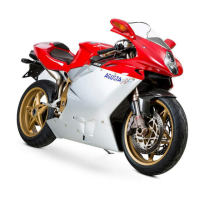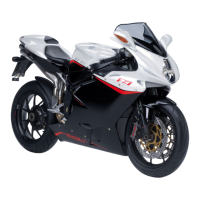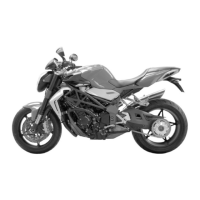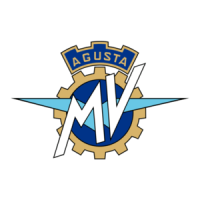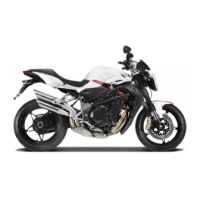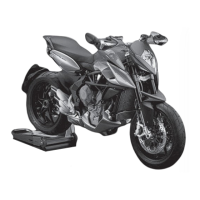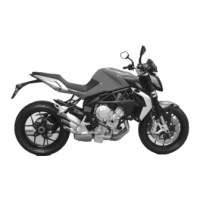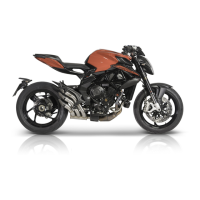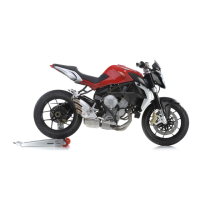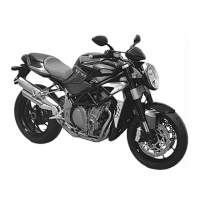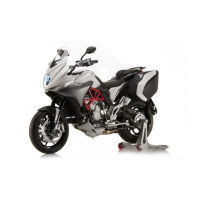
Do you have a question about the MV Agusta TURISMO VELOCE 800 LUSSO and is the answer not in the manual?
| Frame | ALS Steel tubular trellis |
|---|---|
| Engine Type | 3-cylinder, 4-stroke, 12 valve |
| Displacement | 798 cm³ |
| Power | 110 hp (81 kW) at 10, 150 rpm |
| Torque | 80 Nm (8.2 kgm) at 7.100 r.p.m. |
| Transmission | 6 speed |
| Rear Suspension | adjustable rebound and compression damping, spring preload |
| Front Brake | Double floating disc with Ø 320 mm diameter, Brembo radial-type pump and 4-piston calipers |
| Rear Brake | Single 220 mm disc, Brembo 2-piston caliper |
| Traction Control | MVICS (Motor & Vehicle Integrated Control System) with 8-level traction control |
| Electronics | 8-level traction control, Ride-by-Wire, cruise control |
| Fuel system | Electronic fuel injection, Mikuni throttle body |
| Front Suspension | Marzocchi "UPSIDE DOWN" telescopic hydraulic fork with DLC treatment. Rebound-compression damping and spring preload external and separate adjustment |
Provides necessary information for correct and safe operation of the motorcycle.
Explains symbols used for safety, operations, and references within the manual.
Details the importance and handling of the warranty and pre-delivery certificate.
Covers vehicle identification number, engine serial number, and homologation data.
Outlines warranty conditions, exclusions, and authorized service requirements.
Details maintenance intervals, service coupons, and authorized workshop procedures.
Specifies maximum load limits and warnings for safe operation with passengers and luggage.
Identifies and locates key controls and instruments on the motorcycle.
Explains the sidestand and its integrated safety switch function.
Details the functions of buttons and levers on the left handlebar.
Details the functions of buttons and levers on the right handlebar.
Describes the ignition switch positions and steering lock operation.
Explains gear shifting and the Quick Shift function.
Overview of the dashboard display and indicator lights.
Details the meaning and function of various warning lights on the dashboard.
Explains the various readouts and information shown on the multifunction display.
Lists recommended lubricants, fluids, and their specifications.
Basic information and warnings for operating the motorcycle correctly and safely.
Guidelines for the initial running-in period of the engine, tires, and brakes.
Instructions and safety precautions for starting the motorcycle's engine.
Overview of customizable display functions and operating modes.
Procedure for navigating and selecting various functions on the dashboard menu.
Accessing and adjusting general settings like date, clock, and display modes.
Configuration options for date, clock format, and display modes (day/night).
Procedure for entering the immobilizer code in case of system malfunction.
Displays remaining distance or time until the next scheduled maintenance.
Allows adjustment of engine parameters like gas sensitivity and torque levels.
Enables and configures the quick shift system for gear changes without clutch.
Manages phone connectivity, device pairing, and related functions.
Allows selection of measurement units for speed, distance, and temperature.
Displays the current charge level of the motorcycle's battery.
Restores all dashboard parameters to their original factory default settings.
Activates and adjusts the heating level for the handlebar grips.
Adapts suspension settings based on load conditions (Rider only, Rider+Luggage etc.).
Allows activation or deactivation of the Antilock Braking System (ABS).
Adjusts the traction control level to suit driving requirements.
Displays trip counters, odometers, and reset functions.
Selects different engine control unit maps for variable power characteristics.
Adjusts the maximum vehicle speed setting.
Allows selection of the desired cruise control speed.
Accesses phone connection, music player, navigation, and intercom functions.
Manages incoming calls, call answering, and contact lists.
Controls music playback, playlists, and shuffle functions.
Activates voice instructions from a connected GPS navigator.
Enables communication between rider and passenger via Bluetooth.
Exits the Bluetooth menu and returns to the main dashboard screen.
Enables or disables logging data from GPS and vehicle sensors.
Highlights faults or malfunctions detected during operation.
Displays errors detected during the initial self-diagnosis cycle.
Reports errors detected during normal operation, including 'STOP ENGINE'.
Instructions and safety precautions for refuelling the motorcycle.
Procedures for removing and reassembling the passenger and rider seats.
Step-by-step guide on how to remove and reinstall the passenger seat.
Step-by-step guide on how to remove and reinstall the rider seat.
Instructions for opening and closing the front storage compartments.
Procedure for opening, loading, and closing the motorcycle's side bags.
Instructions for detaching and reattaching the side bags.
Details the usage and limitations of the 12V auxiliary power sockets.
Information on the functionality and usage of the USB charging sockets.
Guidance on safely parking the motorcycle using sidestand, central, or rear stand.
Procedure for deploying the sidestand and safety checks.
Instructions for placing and removing the motorcycle from the central stand.
Procedure for lifting the motorcycle using a rear stand.
Overview of adjustable components for ergonomics, geometry, and safety.
Summary table detailing adjustable components and their corresponding sections.
Instructions for adjusting the front brake lever position for rider comfort.
Procedure for adjusting the clutch lever position for optimal grip.
Guidance on adjusting rearview mirrors for optimal visibility.
Instructions for adjusting the windscreen height for riding comfort.
Details adjustments for front suspension spring preload and damping.
Procedure for adjusting the spring preload on the front suspension.
Instructions for adjusting the rebound damping on the front suspension.
Instructions for adjusting the compression damping on the front suspension.
Information and warnings regarding rear shock absorber adjustments.
Procedure for adjusting the spring preload on the rear suspension.
Instructions for adjusting the rebound damping on the rear suspension.
Instructions for adjusting the compression damping on the rear suspension.
Procedure for adjusting the headlight beam angle and height.
